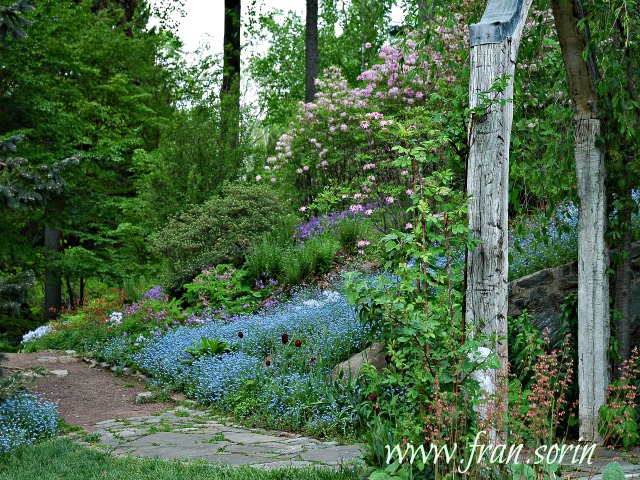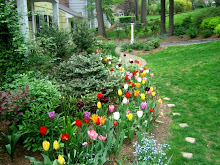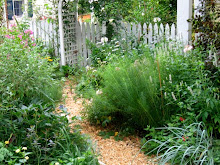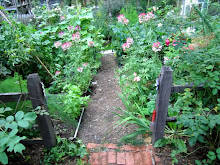As a follow-up to last Wednesday's post, here are the rest of this year's winter containers.
Welcome to Heirloom Gardener
Monday, December 15, 2008
Container Gardening: More of This Year's Containers
Posted by
Julia Erickson
at
12:58 AM
3
comments
![]()
![]()
Labels: Container Gardening, Holidays, Winter Garden
Wednesday, December 10, 2008
Container Gardening: Some of This Year's Winter Containers
As per my recent posts on spray-painted alliums and wreath-making, I am trying do most of my indoor and outdoor Christmas decorating with cuttings from my garden. As a part of this effort, here are some of the winter containers that I have put together this past week. I'm about half-way done and will post pictures of the others after I finish them. If you want to see how they differ from last year's winter containers, click here.
~

Posted by
Julia Erickson
at
10:08 PM
6
comments
![]()
![]()
Labels: Container Gardening, Holidays, Winter Garden
Saturday, October 11, 2008
Container Gardening: Autumn Container (and some Pumpkins and Gourds)
In a prior post on container gardening, I discussed my efforts to change the containers in the front border with the seasons.
In front of the house, the children picked out a selection of pumpkins and gourds from the farmers' market and the local nursery.
Posted by
Julia Erickson
at
9:13 PM
0
comments
![]()
![]()
Labels: Autumn Garden, Container Gardening
Saturday, May 31, 2008
Container Gardening: Summer Containers
Posted by
Julia Erickson
at
10:13 PM
1 comments
![]()
![]()
Labels: Container Gardening, Summer Garden
Sunday, May 18, 2008
Container Gardening: Pictures of Miss Kim Lilac

Posted by
Julia Erickson
at
8:43 PM
1 comments
![]()
![]()
Labels: Container Gardening, Shrubs
Wednesday, April 23, 2008
A Visit to Chanticleer in Wayne, Pennsylvania: Spring Bulbs, Flowering Trees, and Inspiring Containers
I have never been to Chanticleer in the spring. Usually, things are too busy here with spring sports and gardening to go for the day; but with a clear schedule, we went. It was wonderful.
 The most inspiring part of the visit was seeing all the containers. I often find spring pots hard to put together, but with a combination of colored branches from dogwoods and willows, climbing vines, leafy vegetables, and some flowering plants, each pot conveyed the fun and excitement of spring.
The most inspiring part of the visit was seeing all the containers. I often find spring pots hard to put together, but with a combination of colored branches from dogwoods and willows, climbing vines, leafy vegetables, and some flowering plants, each pot conveyed the fun and excitement of spring.




Posted by
Julia Erickson
at
10:35 PM
2
comments
![]()
![]()
Labels: Botanical Gardens, Container Gardening, Spring Garden
Saturday, April 12, 2008
Container Gardening: Dan Benarcik of Chanticleer
 As I have previously written, I am a great fan of Chanticleer. As a part of Gardening Gone Wild's recent Garden Bloggers' Design Workshop on Container Gardening, there is a short post with insights from Dan Benarcik, the horticulturalist who designs many of Chanticleer's inspiring containers. Despite their "over the top couture" appearance, he does try to make their maintenance as simple as possible--planting once for the season, fertilizing once a month, and watering once a day.
As I have previously written, I am a great fan of Chanticleer. As a part of Gardening Gone Wild's recent Garden Bloggers' Design Workshop on Container Gardening, there is a short post with insights from Dan Benarcik, the horticulturalist who designs many of Chanticleer's inspiring containers. Despite their "over the top couture" appearance, he does try to make their maintenance as simple as possible--planting once for the season, fertilizing once a month, and watering once a day.
Posted by
Julia Erickson
at
3:04 PM
1 comments
![]()
![]()
Labels: Botanical Gardens, Container Gardening
Monday, April 07, 2008
Container Gardening: Early Spring Containers - Daffodils, Pansies, Lettuce, and Primrose
 As a follow-up to my recent Gardening Bloggers' Design Workshop post on the variety, soil, and care of containers, here are some pictures of this year's early spring containers. At this stage in the season, it still drops below freezing some nights, so I am limited in what I can plant.
As a follow-up to my recent Gardening Bloggers' Design Workshop post on the variety, soil, and care of containers, here are some pictures of this year's early spring containers. At this stage in the season, it still drops below freezing some nights, so I am limited in what I can plant.  In the pot that is next to my front door (first picture), daffodils greet visitors. At the base of the daffodils, there is a ring of pansies and lettuce (see the detail in the second picture), an idea that I picked up from Chanticleer.
In the pot that is next to my front door (first picture), daffodils greet visitors. At the base of the daffodils, there is a ring of pansies and lettuce (see the detail in the second picture), an idea that I picked up from Chanticleer.
Posted by
Julia Erickson
at
11:03 AM
0
comments
![]()
![]()
Labels: Container Gardening, Spring Garden
Wednesday, March 26, 2008
Garden Bloggers' Design Workshop - Container Plantings: Variety, Soil, and Care
 When I first moved to my current garden, I gardened strictly in containers for the first two years. I covered my 800 square foot deck with everything imaginable, leaving barely enough space for eating and sitting. During that time, I learned a lot about container gardening from both failures and successes. The three most important lessons I learned are: anything can grow in a container; the potting soil matters a great deal; and containers must be cared for and freshened up throughout the year.
When I first moved to my current garden, I gardened strictly in containers for the first two years. I covered my 800 square foot deck with everything imaginable, leaving barely enough space for eating and sitting. During that time, I learned a lot about container gardening from both failures and successes. The three most important lessons I learned are: anything can grow in a container; the potting soil matters a great deal; and containers must be cared for and freshened up throughout the year. Anything Can Grow In A Container
Anything Can Grow In A Container
Anything that grows in the ground can grow in a pot. Containers are not just about annuals. More can be added to the garden by varying the contents of your containers. For example, two years ago I planted a culinary herb garden near our Children's Garden. I found that it was too far from the house to duck out while cooking for a quick snip at an herb or two. So, last year I relocated the herb garden into pots on the deck. I have one huge pot with dill, chives, and basil; one with rosemary, tarragon, and various kinds of thyme; and a few smaller ones with different varieties of basil. I usually grow any new roses I want to try in pots: everything from the small Clotidle Soupert to the rampant climber Cecile Brunner. Evergreens, shrubs, grasses, vines, even trees can be grown in pot. I have had a lilac growing for five years now in a pot on the deck and each year the blooms get better and better. When growing shrubs and trees in pots for the long term, I've learned to treat them as really large bonsai plants. Each year, I renew their soil by removing some and adding organic amendments and manure. Also, every few years I trim off the outer most roots of the plants on one side to allow more root development without the danger of the plant becoming root bound. With this treatment, my lilac is still growing in its original planting pot.
When growing shrubs and trees in pots for the long term, I've learned to treat them as really large bonsai plants. Each year, I renew their soil by removing some and adding organic amendments and manure. Also, every few years I trim off the outer most roots of the plants on one side to allow more root development without the danger of the plant becoming root bound. With this treatment, my lilac is still growing in its original planting pot. The Potting Soil Matters a Great Deal
The Potting Soil Matters a Great Deal
As regards the potting medium, consider again what will be growing in the pot. For tropical plants that like a lot of moisture like elephant ears, I use a heavy potting soil with lots of organic matter added to it that will hold moisture well. This year I am mixing the organic Gardeners' Gold potting soil with dehydrated cow manure. For my roses, that mixture would kill them because the water would sit too long close to their roots. So for roses, I could take the same Gardeners' Gold, but to it add perlite and cow manure so that the proportions are 1:1:1. This yields a rich, well draining soil. For a plant which likes leaner soil, take out the cow manure and use a less organic potting soil as a base. Containers Need Year-Round Care
Containers Need Year-Round Care
Once the container is planted, the care for that container does not stop there. Since containers are their one ecosystem, I must be very attentive to watering, particularly during heat waves, and fertilizing. Usually, I water every morning and sometimes again later if the weather has been particularly brutal. I also fertilize once a week with fish emulsion, sea weed emulsion, or a liquid complete fertilizer.
 After Thanksgiving, I removed the gourds and replaced them with white pine boughs and trimmed back the leaves of the red hot poker for neatness. For this spring, I left the dogwood and the red hot poker. I have added pink primroses and pansies. The constant changing of the containers offers something new for each season and gives me more opportunity to experiment.
After Thanksgiving, I removed the gourds and replaced them with white pine boughs and trimmed back the leaves of the red hot poker for neatness. For this spring, I left the dogwood and the red hot poker. I have added pink primroses and pansies. The constant changing of the containers offers something new for each season and gives me more opportunity to experiment.~
Containers add so much to my garden and plant knowledge. It is a great way to experiment with different plants and combinations without the commitment of planting in the ground. Also, seeing how a plant thrives in a pot with a specific planting medium helps me understand under what conditions it will thrive in the ground.
~
Posted by
Julia Erickson
at
9:58 PM
9
comments
![]()
![]()
Labels: Container Gardening, Garden Bloggers' Design Workshop
Sunday, December 16, 2007
Container Gardening: Autumn Cleanup and Rosemary in Bloom
 In autumn, before the first frost, I move some of my non-hardy plants grown in containers from my deck into more sheltered locations.
In autumn, before the first frost, I move some of my non-hardy plants grown in containers from my deck into more sheltered locations.
Some, I move into the garage so they can go dormant under milder conditions, like my fig tree and a few of my roses. Others, like the elephant ears, I move into the house. The herbs, except the chives and thyme which are hardy and can be left outdoors, I have usually treated as annuals.
This year, I brought my rosemary plant indoors and, to my surprise, it started blooming. It is now covered with the small, light purple flowers that you see in these pictures.
Posted by
Julia Erickson
at
4:11 PM
0
comments
![]()
![]()
Labels: Container Gardening, Heirloom and Organic Food, Pruning and Maintenance
Monday, December 03, 2007
The Hellenbrechts in Ohio: Christmas Green
Here are some more ideas about winter containers:
The Hellenbrechts in Ohio: Christmas Green
Posted by
Julia Erickson
at
10:17 PM
0
comments
![]()
![]()
Labels: Container Gardening, Gardening Blogs, Winter Garden
Sunday, December 02, 2007
Container Gardening: Winter Containers
Yesterday, before today's snow, I replanted all my planters in the front garden for the winter. I love having something beautiful to look at when most of the garden is sleeping. For inspiration this year, I looked at some photographs I took at the Missouri Botanical Garden (http://mobot.org/) last winter.
The first pot has a yellow twig dogwood as its base. From there, I added boughs of white pine and dried hydrangea blossoms from a Pee Gee hydrangea in the garden. 
On the front porch is an urn whose plantings change every season. For winter, I have cut branches of winterberry surrounded by dried statice and white pine branches. Also, added are some large pine cones from a collection my husband and I have gathered over the years.
Near the lamp post is a small pot atop a column which has Douglas fir clippings, some faux winterberries, and pine cones. Since this pot is in a more exposed position than the one on the porch, in the the past I have found that real winterberries do not hold up as well.
The last pot I did is in front of the living room. In the center of the pot are branches cut from a red twig dogwood surrounded by more Douglas fir branches. A few pine cones were added also. 
The pots will add interest to the garden until spring comes and are easy to do. You can use cuttings from your own garden, buy some from local nurseries, or from White Flower Farm (http://www.whiteflowerfarm.com/) who sells a wonderful 14 pound box of winter greens.
Posted by
Julia Erickson
at
3:16 PM
2
comments
![]()
![]()
Labels: Container Gardening, Front Border, Holidays, Winter Garden
Search Heirloom Gardener
Labels
- About Blogging
- Annuals/Biennials and Perennials
- Autumn Garden
- Books and Movies
- Botanical Gardens
- Bulbs and Tubers
- Children's Garden
- Chrysanthemum
- Clematis
- Container Gardening
- Crocus tommasiniasus roseus
- Cut and Forced Flowers
- Cutting and Rose Gardens
- Dahlias
- Deep Thoughts About Gardening
- Egg Garden
- Fences Arbors Walls and Paths
- Floral arrangements
- Front Border
- Fun Stories About Gardening
- Garden Bloggers' Bloom Day
- Garden Bloggers' Design Workshop
- Garden Planning
- Gardening Blogs
- Gardening Tools and Structures
- Gardening with Children
- Goldberry Hill
- Heirloom and Organic Food
- Hibiscus
- Holidays
- Hydrangeas
- Japanese Beautyberry
- Lilies
- Mixed Borders
- New Jersey / Local Interest
- Nurseries
- Online Gardening Resources
- Peonies
- Pest Control
- Picture This Photo Contest
- Piet Oudolf
- Poppies
- Propagation and Seeds
- Pruning and Maintenance
- Roses
- Seed Heads
- Self Seeders
- Shrubs
- Spring Garden
- Summer Garden
- Trees
- Wildlife in the Garden
- Winter Garden
- Zinia






























